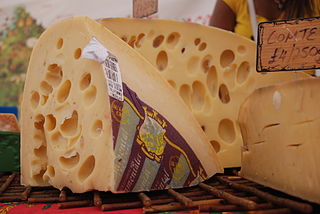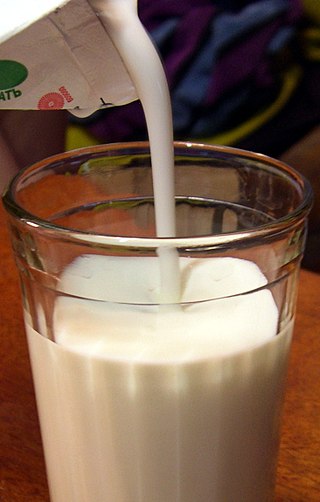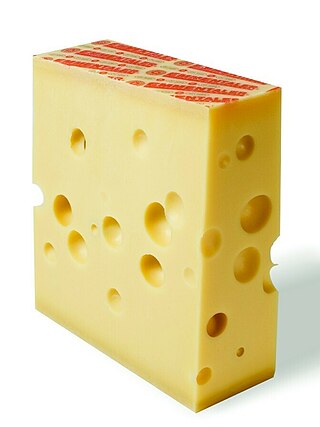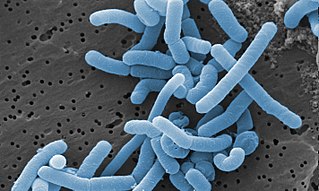
Swiss cheese is any variety of cheese that resembles Emmental cheese, a yellow, medium-hard cheese that originated in the area around Emmental, Switzerland. It is classified as a Swiss-type or Alpine cheese. Some types of Swiss cheese have a distinctive appearance, as the blocks or rounds of the cheese are riddled with holes known as "eyes". Swiss cheese without eyes is known as "blind".

Lactobacillus bulgaricus is the main bacterium used for the production of yogurt. It also plays a crucial role in the ripening of some cheeses, as well as in other processes involving naturally fermented products. It is defined as homofermentive lactic acid bacteria due to lactic acid being the single end product of its carbohydrate digestion. It is also considered a probiotic.

Propionic acid is a naturally occurring carboxylic acid with chemical formula CH
3CH
2CO
2H. It is a liquid with a pungent and unpleasant smell somewhat resembling body odor. The anion CH
3CH
2CO−
2 as well as the salts and esters of propionic acid are known as propionates or propanoates.

Lactococcus lactis is a gram-positive bacterium used extensively in the production of buttermilk and cheese, but has also become famous as the first genetically modified organism to be used alive for the treatment of human disease. L. lactis cells are cocci that group in pairs and short chains, and, depending on growth conditions, appear ovoid with a typical length of 0.5 - 1.5 µm. L. lactis does not produce spores (nonsporulating) and are not motile (nonmotile). They have a homofermentative metabolism, meaning they produce lactic acid from sugars. They've also been reported to produce exclusive L-(+)-lactic acid. However, reported D-(−)-lactic acid can be produced when cultured at low pH. The capability to produce lactic acid is one of the reasons why L. lactis is one of the most important microorganisms in the dairy industry. Based on its history in food fermentation, L. lactis has generally recognized as safe (GRAS) status, with few case reports of it being an opportunistic pathogen.

Probiotics are live microorganisms promoted with claims that they provide health benefits when consumed, generally by improving or restoring the gut microbiota. Probiotics are considered generally safe to consume, but may cause bacteria-host interactions and unwanted side effects in rare cases. There is some evidence that probiotics are beneficial for some conditions, but there is little evidence for many of the health benefits claimed for them.

Propionibacterium is a gram-positive, anaerobic, rod-shaped genus of bacteria named for their unique metabolism: They are able to synthesize propionic acid by using unusual transcarboxylase enzymes.

Lactobacillus acidophilus is a rod-shaped, Gram-positive, homofermentative, anaerobic microbe first isolated from infant feces in the year 1900. The species is most commonly found in humans, specifically the gastrointestinal tract, oral cavity, and vagina, as well as various fermented foods such as fermented milk or yogurt. The species most readily grows at low pH levels, and has an optimum growth temperature of 37 °C. Certain strains of L. acidophilus show strong probiotic effects, and are commercially used in dairy production. The genome of L. acidophilus has been sequenced.

Lacticaseibacillus casei is an organism that belongs to the largest genus in the family Lactobacillaceae, a lactic acid bacteria (LAB), that was previously classified as Lactobacillus casei. This bacteria has been identified as facultatively anaerobic or microaerophilic, acid-tolerant, non-spore-forming bacteria.

Lacticaseibacillus rhamnosus is a bacterium that originally was considered to be a subspecies of L. casei, but genetic research found it to be a separate species in the L. casei clade, which also includes L. paracasei and L. zeae. It is a short Gram-positive homofermentative facultative anaerobic non-spore-forming rod that often appears in chains. Some strains of L. rhamnosus bacteria are being used as probiotics, and are particularly useful in treating infections of the female urogenital tract, most particularly very difficult to treat cases of bacterial vaginosis. The species Lacticaseibacillus rhamnosus and Limosilactobacillus reuteri are commonly found in the healthy female genito-urinary tract and are helpful to regain control of dysbiotic bacterial overgrowth during an active infection. L. rhamnosus sometimes is used in dairy products such as fermented milk and as non-starter-lactic acid bacterium (NSLAB) in long-ripened cheese. While frequently considered a beneficial organism, L. rhamnosus may not be as beneficial to certain subsets of the population; in rare circumstances, especially those primarily involving weakened immune system or infants, it may cause endocarditis. Despite the rare infections caused by L. rhamnosus, the species is included in the list of bacterial species with qualified presumed safety (QPS) status of the European Food Safety Agency.

Lactobacillales are an order of gram-positive, low-GC, acid-tolerant, generally nonsporulating, nonrespiring, either rod-shaped (bacilli) or spherical (cocci) bacteria that share common metabolic and physiological characteristics. These bacteria, usually found in decomposing plants and milk products, produce lactic acid as the major metabolic end product of carbohydrate fermentation, giving them the common name lactic acid bacteria (LAB).
Leuconostoc mesenteroides is a species of lactic acid bacteria associated with fermentation, under conditions of salinity and low temperatures. In some cases of vegetable and food storage, it was associated with pathogenicity. L. mesenteroides is approximately 0.5-0.7 µm in diameter and has a length of 0.7-1.2 µm, producing small grayish colonies that are typically less than 1.0 mm in diameter. It is facultatively anaerobic, Gram-positive, non-motile, non-sporogenous, and spherical. It often forms lenticular coccoid cells in pairs and chains, however, it can occasionally form short rods with rounded ends in long chains, as its shape can differ depending on what media the species is grown on. L. mesenteroides grows best at 30 °C, but can survive in temperatures ranging from 10 °C to 30 °C. Its optimum pH is 5.5, but can still show growth in pH of 4.5-7.0.

Food microbiology is the study of the microorganisms that inhabit, create, or contaminate food. This includes the study of microorganisms causing food spoilage; pathogens that may cause disease ; microbes used to produce fermented foods such as cheese, yogurt, bread, beer, and wine; and microbes with other useful roles, such as producing probiotics.

Streptococcus thermophilus formerly known as Streptococcus salivarius subsp. thermophilus is a gram-positive bacterium, and a fermentative facultative anaerobe, of the viridans group. It tests negative for cytochrome, oxidase, and catalase, and positive for alpha-hemolytic activity. It is non-motile and does not form endospores. S. thermophilus is fimbriated.
Lactobacillus helveticus is a lactic-acid producing, rod-shaped bacterium of the genus Lactobacillus. It is most commonly used in the production of American Swiss cheese and Emmental cheese, but is also sometimes used in making other styles of cheese, such as Cheddar, Parmesan, Romano, provolone, and mozzarella. The primary function of L. helveticus culture is to prevent bitterness and produce nutty flavors in the final cheese. In Emmental cheese production, L. helveticus is used in conjunction with a Propionibacterium culture, which is responsible for developing the holes through production of carbon dioxide gas.

Kefir is a fermented milk drink similar to a thin yogurt or ayran that is made from kefir grains, a specific type of mesophilic symbiotic culture. It is prepared by inoculating the milk of cows, goats, or sheep with kefir grains.

Eyes are the round holes that are a characteristic feature of Swiss-type cheese and some Dutch-type cheeses. The eyes are bubbles of carbon dioxide gas. The gas is produced by various species of bacteria in the cheese.

Cheese ripening, alternatively cheese maturation or affinage, is a process in cheesemaking. It is responsible for the distinct flavour of cheese, and through the modification of "ripening agents", determines the features that define many different varieties of cheeses, such as taste, texture, and body. The process is "characterized by a series of complex physical, chemical and microbiological changes" that incorporates the agents of "bacteria and enzymes of the milk, lactic culture, rennet, lipases, added moulds or yeasts, and environmental contaminants". The majority of cheese is ripened, except for fresh cheese.
Cultured dextrose is a food additive used to inhibit the growth of undesirable bacteria and mold in food. Often used in place of benzoates and sorbates, it is considered by some consumers to be a more "natural" ingredient, because it is prepared by the fermentation of milk or sugar powders by the probiotic bacteria Propionibacterium freudenreichii and Lactococcus lactis, both of which are extensively used in the production of cheese and other dairy products.
Microbial food cultures are live bacteria, yeasts or moulds used in food production. Microbial food cultures carry out the fermentation process in foodstuffs. Used by humans since the Neolithic period fermentation helps to preserve perishable foods and to improve their nutritional and organoleptic qualities. As of 1995, fermented food represented between one quarter and one third of food consumed in Central Europe. More than 260 different species of microbial food culture are identified and described for their beneficial use in fermented food products globally, showing the importance of their use.

Lacticaseibacillus paracasei (commonly abbreviated as Lc. paracasei) is a gram-positive, homofermentative species of lactic acid bacteria that are commonly used in dairy product fermentation and as probiotic cultures. Lc. paracasei is a bacterium that operates by commensalism. It is commonly found in many human habitats such as human intestinal tracts and mouths as well as sewages, silages, and previously mentioned dairy products. The name includes morphology, a rod-shaped bacterium with a width of 2.0 to 4.0μm and length of 0.8 to 1.0μm.















